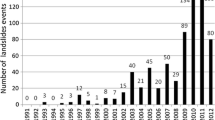Abstract
Capacity development is important and urgently needed for landslide disaster risk reduction. This is especially so in developing countries where mountain and urban development is accelerating most rapidly, including construction of highways and railways and residential complexes. However, effective tools to teach practical landslide risk reduction knowledge and skills are not available. Therefore, International Consortium on Landslides (ICL) has decided to compile a collection of landslide teaching tools (Sassa et al. 2013) to provide teaching materials to ICL members and other landslide teaching entities to assist in education of university students, local government officers, staff in nongovernmental organizations, and the public. The teaching toolbox contains five parts: (1) mapping and site prediction; (2) monitoring and early warning; (3) testing and numerical simulation; (4) risk management; and (5) country practices and case studies. The teaching toolbox contains three types of tools: (1) TXT tools consisting of original texts with figures; (2) PDF tools consisting of already published reference papers, manuals, guidelines, and others; and (3) PPT tools consisting of PowerPoint® files made for lectures. The initial TXT tools have been published as a full color booklet (405 pages). The PDF tools and PPT tools are contained in a CD. The basic concept and a list of contents of the ICL landslide teaching tools are introduced in this article.


Similar content being viewed by others
References
International Consortium on Landslides Leaflet 2012 (60 pages) is downloaded from the ICL WEB http://icl.iplhq.org/category /home-icl/ or directly from http://iplhq.org/icl/wp-content/uploads/2012/12/ICL2012s2012 0705215642.pdf
Sassa K (2012) ICL strategic plan 2012–2021 – to create a safer geoenvironment. Landslides 9(2):155–164
Sassa K, He B, McSaveney M, Nagai O (2013) ICL Landslide Teaching Tools. ISBN: 978-4-9903382-2-0. ICL Press, 405 pages
Acknowledgments
The ICL Landslide Teaching Tool project was proposed in accord with the ICL strategic plan 2012–2022 to create a safer geo-environment. This initial activity was supported by the UNESCO activity supporting fund of the Director-General Office for International Affairs of the Ministry of Education, Culture, Sports, Science and Technology (MEXT), Japan. The project is supported by the Science and Technology Research Partnership for Sustainable Development Programme (SATREPS) of the Japan Science and Technology Agency (JST) and the Japan International Cooperation Agency (JICA). This initiative is a part of the International Programme on Landslides (IPL) which is jointly established by ICL, UNESCO, WMO, FAO, UNISDR, UNU, ICSU, WFEO, and IUGS by the 2006 Tokyo Action Plan. The ICL teaching tools contribute to the UNESCO’s University Twinning and Networking (UNITWIN) Cooperation Programme “Landslide and Water-Related Disaster Risk Management for Society and the Environment” implemented by UNESCO, Kyoto University, and ICL.
Author information
Authors and Affiliations
Corresponding author
Rights and permissions
About this article
Cite this article
He, B., Sassa, K., McSaveney, M. et al. Development of ICL landslide teaching tools. Landslides 11, 153–159 (2014). https://doi.org/10.1007/s10346-013-0460-y
Received:
Accepted:
Published:
Issue Date:
DOI: https://doi.org/10.1007/s10346-013-0460-y




